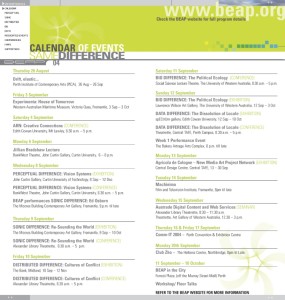BEAPWORKS05 Call for works
Friday, March 4th, 2005
Grants of up to $10,000 are available to artists in 2005 for adventurous new art projects that utilise emerging technologies in areas such as digital, time-based, broadband, screen-based and biological art.
CLOSING D
ATE: 4th March 2005, at 5pm
About BEAPworks
BEAPworks is a research and development grant funding adventurous new art projects utilising emergent technologies for Western Australian artists.
BEAPworks is a joint initiative between the Biennale of Electronic Arts, Perth and ArtsWA. BEAP is supported by the Visual Arts and Craft Strategy, an initiative of the Australian, State and Territory Governments and the Government of Western Australia through ArtsWA in association with Lotterywest.
About the BEAPworks Exhibition
Recipients of the BEAPworks 2004 grant round are being exhibited as part of the Perth International Arts Festival at John Curtin Gallery, Curtin University. The exhibition runs from 10 February until 12 June 2005.
BEAPworks is curated by Paul Thomas, the Director of BEAP. The exhibition presents the work of six local electronic artists, Mark Cypher, Cat Hope, Jo Law with Hilary Bunt & Raoul Marks, Cameron Merton with Yvette Merton, Nina Sellars with Iain Sweetman & Gareth Lockett, and Cynthia Verspaget. The works explore the way the world is shaped by scientific development. Through the interactive multimedia installations the works provide access to understanding how these scientific developments affect our perception of daily life.
More information on the artists can be found online at www.beap.org
BEAPworks exhibition:
John Curtin Gallery, Building 200 (Opposite the Kirribilli Café)
Curtin University of Technology, Kent St, BENTLEY WA
Opening hours Tuesday to Friday 10.30am – 5pm, Sunday 1 – 5pm
Admission is free
BEAPworks Grant Aims
BEAPworks grants assist in the creation new, cutting edge and experimental electronic and/ or biological art projects.
The BEAPworks grant aims to:
- • stimulate and cultivate electronic and emerging technology based artwork, by local emerging and practicing artists
- • assist in the development of innovative artwork, leading to the realisation of artistic outcomes, at an international standard
- • stimulate artistic research and development allowing artists to explore ideas uncovered by new developments in emerging technology
BEAP strongly recommends that all grant applicants visit the exhibition, as this will enhance understanding of the aims of the BEAPworks grant.
Funding Criteria
BEAPworks grants are awarded, by a panel, on the following considerations.
The extent to which the project:
- • is cutting edge, innovative or experimental
- • uses emerging/ electronic technologies in areas such
as digital, time-based, broadband, screen-based and biological art
- • holds strengths in research and development
- • has the potential for external collaborations, or explores external collaborations
- • has clearly defined aims, strategies and expected project outcomes
- • has evidence that the project is well planned and achievable with consideration given to financial management, proposal concept and technical requirements
Guidelines and Conditions
To be accepted, all BEAPworks applications must follow these guidelines and conditions:
- • BEAPworks grants are only available to Western Australia artists
- • Applicants must be Australian citizens or have permanent resident status in Australia;
- • Applicants must have resided in Western Australia for at least 12 months immediately prior to making an application;
- • Applicants must not have any overdue acquittals from previous ArtsWA funding;
- • Applicants must have an Australian Business Number (ABN) or proof that they are not subject to Pay As You Go (PAYG) withholding
- • Students and organisations cannot apply to fund works for student based exhibitions
- • Funding will not be given to capital equipment
- • Only 1 application from each individual can be submitted
- Applicants must be over 18 years of age
Other Research/ Residency Opportunities
Residencies offered in partnership with BEAPworks will be negotiated directly between the artist and the organisation. Residencies offered are:
- • Physical residency space at CLEAR (Centre for Living, Electronic Arts Research): a dedicated research centre at the intersection of art, science and industry. Space is negotiable based on acceptance of a proposal.
- • Online residency space at CLEAR: offers interactive server access, file sharing, ftp access and web presence.
- • Online research facilities: offers online collaborative research space.
- • BEAPworks ISA Technologies HPC Fellowship: provides access to a high performance computing and visualisation facility through ISA Technologies (Applicants must have strong computer knowledge)
Successful Applicants
Successful applicants will be notified via mail.
The ArtsWA Grants Administrator will contact each successful applicant detailing the conditions and requirements applying to this offer.
Successful applicants must acknowledge such support in all publicity and promotional material, including websites, email notification and verbally, when relating to this project.
Un-successful Applicants
Un-successful applicants will be notified via mail.
How do I apply?
Fill in all questions on the BEAPworks grant submission form.
Complete the budget form.
Applications must:
- • be submitted via post (to the below address) or via email (to info@beap.org)
- • be short, concise, relevant and legible
- • not be bound, and must be printed on one side only (paper version only)
- • contain relevant support material (do not send original copies)
- • all support material must be labelled clearly with your name and contact details
Send the application via post to:
BEAPworks application
Centre for Living and Electronic Arts Research (CLEAR)
Suite 3 Enterprise Building 3
11 Brodie Hall Drive
Bentley, WA, 6102
CLOSING DATE: 4th March 2005, at 5pm
Need more information?
Contact Amanda Alderson, BEAP administrator on 9266 4922 (until the 11th of February) then on
6424 8203 (from the 14th of February) or via info@beap.org, for more information, or to discuss proposals.




